Qingsen Yan
GMODiff: One-Step Gain Map Refinement with Diffusion Priors for HDR Reconstruction
Dec 18, 2025Abstract:Pre-trained Latent Diffusion Models (LDMs) have recently shown strong perceptual priors for low-level vision tasks, making them a promising direction for multi-exposure High Dynamic Range (HDR) reconstruction. However, directly applying LDMs to HDR remains challenging due to: (1) limited dynamic-range representation caused by 8-bit latent compression, (2) high inference cost from multi-step denoising, and (3) content hallucination inherent to generative nature. To address these challenges, we introduce GMODiff, a gain map-driven one-step diffusion framework for multi-exposure HDR reconstruction. Instead of reconstructing full HDR content, we reformulate HDR reconstruction as a conditionally guided Gain Map (GM) estimation task, where the GM encodes the extended dynamic range while retaining the same bit depth as LDR images. We initialize the denoising process from an informative regression-based estimate rather than pure noise, enabling the model to generate high-quality GMs in a single denoising step. Furthermore, recognizing that regression-based models excel in content fidelity while LDMs favor perceptual quality, we leverage regression priors to guide both the denoising process and latent decoding of the LDM, suppressing hallucinations while preserving structural accuracy. Extensive experiments demonstrate that our GMODiff performs favorably against several state-of-the-art methods and is 100 faster than previous LDM-based methods.
HVI-CIDNet+: Beyond Extreme Darkness for Low-Light Image Enhancement
Jul 09, 2025Abstract:Low-Light Image Enhancement (LLIE) aims to restore vivid content and details from corrupted low-light images. However, existing standard RGB (sRGB) color space-based LLIE methods often produce color bias and brightness artifacts due to the inherent high color sensitivity. While Hue, Saturation, and Value (HSV) color space can decouple brightness and color, it introduces significant red and black noise artifacts. To address this problem, we propose a new color space for LLIE, namely Horizontal/Vertical-Intensity (HVI), defined by the HV color map and learnable intensity. The HV color map enforces small distances for the red coordinates to remove red noise artifacts, while the learnable intensity compresses the low-light regions to remove black noise artifacts. Additionally, we introduce the Color and Intensity Decoupling Network+ (HVI-CIDNet+), built upon the HVI color space, to restore damaged content and mitigate color distortion in extremely dark regions. Specifically, HVI-CIDNet+ leverages abundant contextual and degraded knowledge extracted from low-light images using pre-trained vision-language models, integrated via a novel Prior-guided Attention Block (PAB). Within the PAB, latent semantic priors can promote content restoration, while degraded representations guide precise color correction, both particularly in extremely dark regions through the meticulously designed cross-attention fusion mechanism. Furthermore, we construct a Region Refinement Block that employs convolution for information-rich regions and self-attention for information-scarce regions, ensuring accurate brightness adjustments. Comprehensive results from benchmark experiments demonstrate that the proposed HVI-CIDNet+ outperforms the state-of-the-art methods on 10 datasets.
NTIRE 2025 Challenge on Efficient Burst HDR and Restoration: Datasets, Methods, and Results
May 17, 2025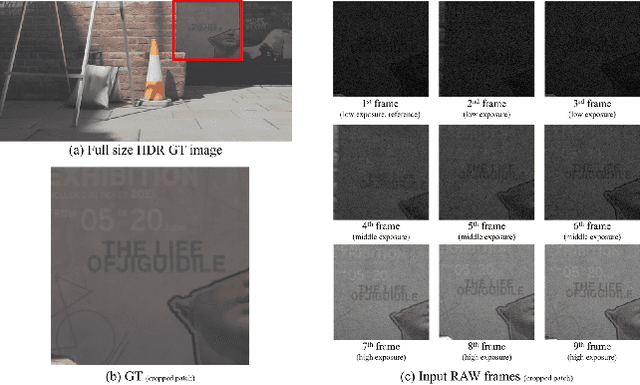
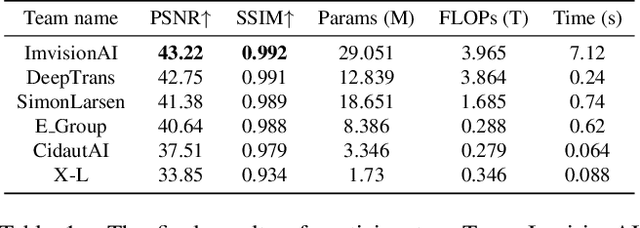
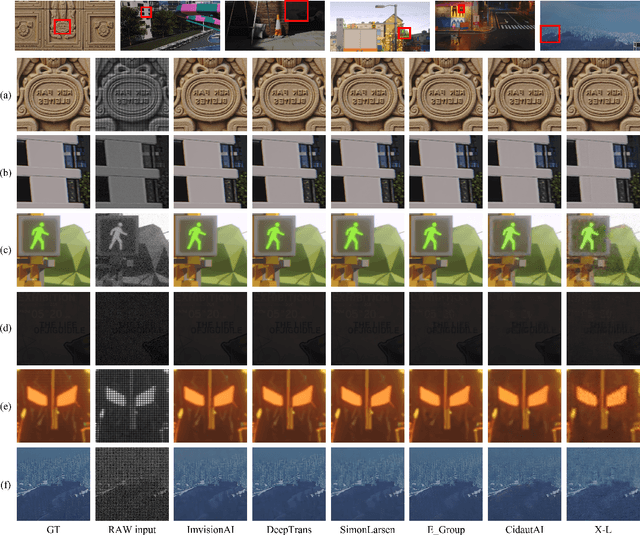
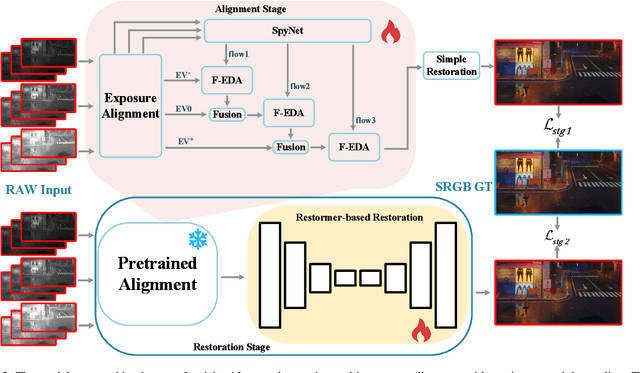
Abstract:This paper reviews the NTIRE 2025 Efficient Burst HDR and Restoration Challenge, which aims to advance efficient multi-frame high dynamic range (HDR) and restoration techniques. The challenge is based on a novel RAW multi-frame fusion dataset, comprising nine noisy and misaligned RAW frames with various exposure levels per scene. Participants were tasked with developing solutions capable of effectively fusing these frames while adhering to strict efficiency constraints: fewer than 30 million model parameters and a computational budget under 4.0 trillion FLOPs. A total of 217 participants registered, with six teams finally submitting valid solutions. The top-performing approach achieved a PSNR of 43.22 dB, showcasing the potential of novel methods in this domain. This paper provides a comprehensive overview of the challenge, compares the proposed solutions, and serves as a valuable reference for researchers and practitioners in efficient burst HDR and restoration.
FusionNet: Multi-model Linear Fusion Framework for Low-light Image Enhancement
Apr 27, 2025Abstract:The advent of Deep Neural Networks (DNNs) has driven remarkable progress in low-light image enhancement (LLIE), with diverse architectures (e.g., CNNs and Transformers) and color spaces (e.g., sRGB, HSV, HVI) yielding impressive results. Recent efforts have sought to leverage the complementary strengths of these paradigms, offering promising solutions to enhance performance across varying degradation scenarios. However, existing fusion strategies are hindered by challenges such as parameter explosion, optimization instability, and feature misalignment, limiting further improvements. To overcome these issues, we introduce FusionNet, a novel multi-model linear fusion framework that operates in parallel to effectively capture global and local features across diverse color spaces. By incorporating a linear fusion strategy underpinned by Hilbert space theoretical guarantees, FusionNet mitigates network collapse and reduces excessive training costs. Our method achieved 1st place in the CVPR2025 NTIRE Low Light Enhancement Challenge. Extensive experiments conducted on synthetic and real-world benchmark datasets demonstrate that the proposed method significantly outperforms state-of-the-art methods in terms of both quantitative and qualitative results, delivering robust enhancement under diverse low-light conditions.
AVadCLIP: Audio-Visual Collaboration for Robust Video Anomaly Detection
Apr 06, 2025



Abstract:With the increasing adoption of video anomaly detection in intelligent surveillance domains, conventional visual-based detection approaches often struggle with information insufficiency and high false-positive rates in complex environments. To address these limitations, we present a novel weakly supervised framework that leverages audio-visual collaboration for robust video anomaly detection. Capitalizing on the exceptional cross-modal representation learning capabilities of Contrastive Language-Image Pretraining (CLIP) across visual, audio, and textual domains, our framework introduces two major innovations: an efficient audio-visual fusion that enables adaptive cross-modal integration through lightweight parametric adaptation while maintaining the frozen CLIP backbone, and a novel audio-visual prompt that dynamically enhances text embeddings with key multimodal information based on the semantic correlation between audio-visual features and textual labels, significantly improving CLIP's generalization for the video anomaly detection task. Moreover, to enhance robustness against modality deficiency during inference, we further develop an uncertainty-driven feature distillation module that synthesizes audio-visual representations from visual-only inputs. This module employs uncertainty modeling based on the diversity of audio-visual features to dynamically emphasize challenging features during the distillation process. Our framework demonstrates superior performance across multiple benchmarks, with audio integration significantly boosting anomaly detection accuracy in various scenarios. Notably, with unimodal data enhanced by uncertainty-driven distillation, our approach consistently outperforms current unimodal VAD methods.
Boosting HDR Image Reconstruction via Semantic Knowledge Transfer
Mar 19, 2025Abstract:Recovering High Dynamic Range (HDR) images from multiple Low Dynamic Range (LDR) images becomes challenging when the LDR images exhibit noticeable degradation and missing content. Leveraging scene-specific semantic priors offers a promising solution for restoring heavily degraded regions. However, these priors are typically extracted from sRGB Standard Dynamic Range (SDR) images, the domain/format gap poses a significant challenge when applying it to HDR imaging. To address this issue, we propose a general framework that transfers semantic knowledge derived from SDR domain via self-distillation to boost existing HDR reconstruction. Specifically, the proposed framework first introduces the Semantic Priors Guided Reconstruction Model (SPGRM), which leverages SDR image semantic knowledge to address ill-posed problems in the initial HDR reconstruction results. Subsequently, we leverage a self-distillation mechanism that constrains the color and content information with semantic knowledge, aligning the external outputs between the baseline and SPGRM. Furthermore, to transfer the semantic knowledge of the internal features, we utilize a semantic knowledge alignment module (SKAM) to fill the missing semantic contents with the complementary masks. Extensive experiments demonstrate that our method can significantly improve the HDR imaging quality of existing methods.
HVI: A New Color Space for Low-light Image Enhancement
Feb 28, 2025



Abstract:Low-Light Image Enhancement (LLIE) is a crucial computer vision task that aims to restore detailed visual information from corrupted low-light images. Many existing LLIE methods are based on standard RGB (sRGB) space, which often produce color bias and brightness artifacts due to inherent high color sensitivity in sRGB. While converting the images using Hue, Saturation and Value (HSV) color space helps resolve the brightness issue, it introduces significant red and black noise artifacts. To address this issue, we propose a new color space for LLIE, namely Horizontal/Vertical-Intensity (HVI), defined by polarized HS maps and learnable intensity. The former enforces small distances for red coordinates to remove the red artifacts, while the latter compresses the low-light regions to remove the black artifacts. To fully leverage the chromatic and intensity information, a novel Color and Intensity Decoupling Network (CIDNet) is further introduced to learn accurate photometric mapping function under different lighting conditions in the HVI space. Comprehensive results from benchmark and ablation experiments show that the proposed HVI color space with CIDNet outperforms the state-of-the-art methods on 10 datasets. The code is available at https://github.com/Fediory/HVI-CIDNet.
Rethinking Token Reduction in MLLMs: Towards a Unified Paradigm for Training-Free Acceleration
Nov 26, 2024



Abstract:To accelerate the inference of heavy Multimodal Large Language Models (MLLMs), this study rethinks the current landscape of training-free token reduction research. We regret to find that the critical components of existing methods are tightly intertwined, with their interconnections and effects remaining unclear for comparison, transfer, and expansion. Therefore, we propose a unified ''filter-correlate-compress'' paradigm that decomposes the token reduction into three distinct stages within a pipeline, maintaining consistent design objectives and elements while allowing for unique implementations. We additionally demystify the popular works and subsume them into our paradigm to showcase its universality. Finally, we offer a suite of methods grounded in the paradigm, striking a balance between speed and accuracy throughout different phases of the inference. Experimental results across 10 benchmarks indicate that our methods can achieve up to an 82.4% reduction in FLOPs with a minimal impact on performance, simultaneously surpassing state-of-the-art training-free methods. Our project page is at https://ficoco-accelerate.github.io/.
Efficient Adaptation of Pre-trained Vision Transformer via Householder Transformation
Oct 30, 2024
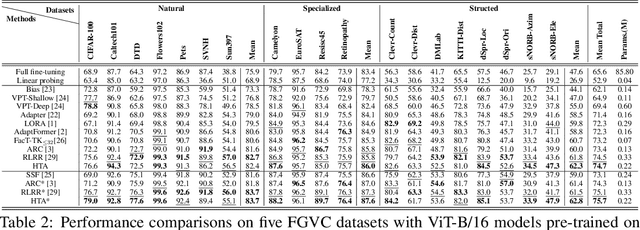

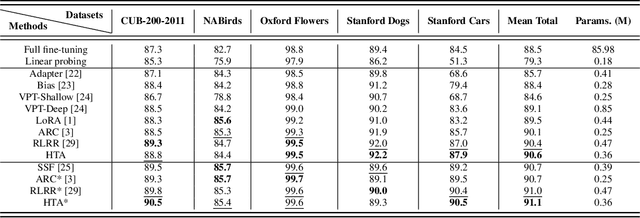
Abstract:A common strategy for Parameter-Efficient Fine-Tuning (PEFT) of pre-trained Vision Transformers (ViTs) involves adapting the model to downstream tasks by learning a low-rank adaptation matrix. This matrix is decomposed into a product of down-projection and up-projection matrices, with the bottleneck dimensionality being crucial for reducing the number of learnable parameters, as exemplified by prevalent methods like LoRA and Adapter. However, these low-rank strategies typically employ a fixed bottleneck dimensionality, which limits their flexibility in handling layer-wise variations. To address this limitation, we propose a novel PEFT approach inspired by Singular Value Decomposition (SVD) for representing the adaptation matrix. SVD decomposes a matrix into the product of a left unitary matrix, a diagonal matrix of scaling values, and a right unitary matrix. We utilize Householder transformations to construct orthogonal matrices that efficiently mimic the unitary matrices, requiring only a vector. The diagonal values are learned in a layer-wise manner, allowing them to flexibly capture the unique properties of each layer. This approach enables the generation of adaptation matrices with varying ranks across different layers, providing greater flexibility in adapting pre-trained models. Experiments on standard downstream vision tasks demonstrate that our method achieves promising fine-tuning performance.
TG-LLaVA: Text Guided LLaVA via Learnable Latent Embeddings
Sep 15, 2024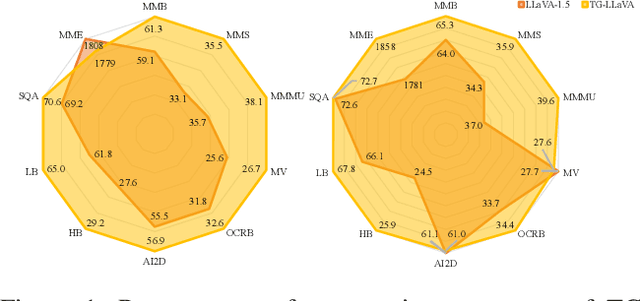
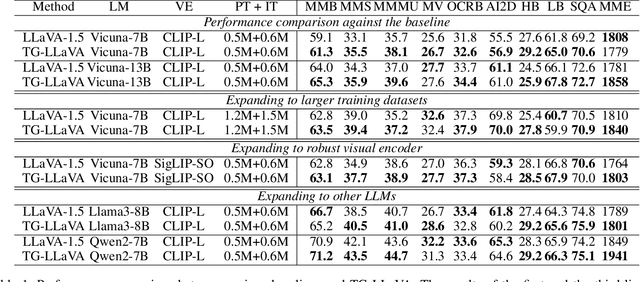
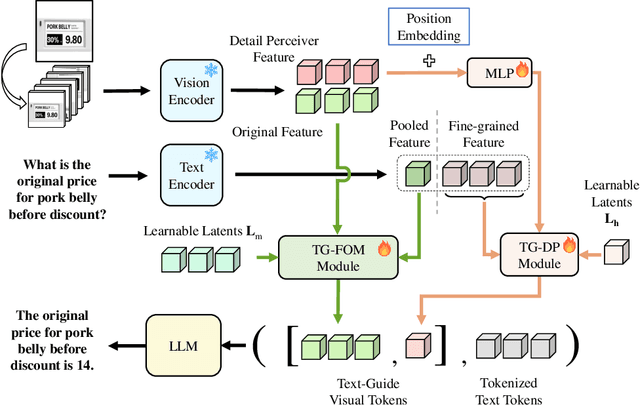

Abstract:Currently, inspired by the success of vision-language models (VLMs), an increasing number of researchers are focusing on improving VLMs and have achieved promising results. However, most existing methods concentrate on optimizing the connector and enhancing the language model component, while neglecting improvements to the vision encoder itself. In contrast, we propose Text Guided LLaVA (TG-LLaVA) in this paper, which optimizes VLMs by guiding the vision encoder with text, offering a new and orthogonal optimization direction. Specifically, inspired by the purpose-driven logic inherent in human behavior, we use learnable latent embeddings as a bridge to analyze textual instruction and add the analysis results to the vision encoder as guidance, refining it. Subsequently, another set of latent embeddings extracts additional detailed text-guided information from high-resolution local patches as auxiliary information. Finally, with the guidance of text, the vision encoder can extract text-related features, similar to how humans focus on the most relevant parts of an image when considering a question. This results in generating better answers. Experiments on various datasets validate the effectiveness of the proposed method. Remarkably, without the need for additional training data, our propsoed method can bring more benefits to the baseline (LLaVA-1.5) compared with other concurrent methods. Furthermore, the proposed method consistently brings improvement in different settings.
 Add to Chrome
Add to Chrome Add to Firefox
Add to Firefox Add to Edge
Add to Edge